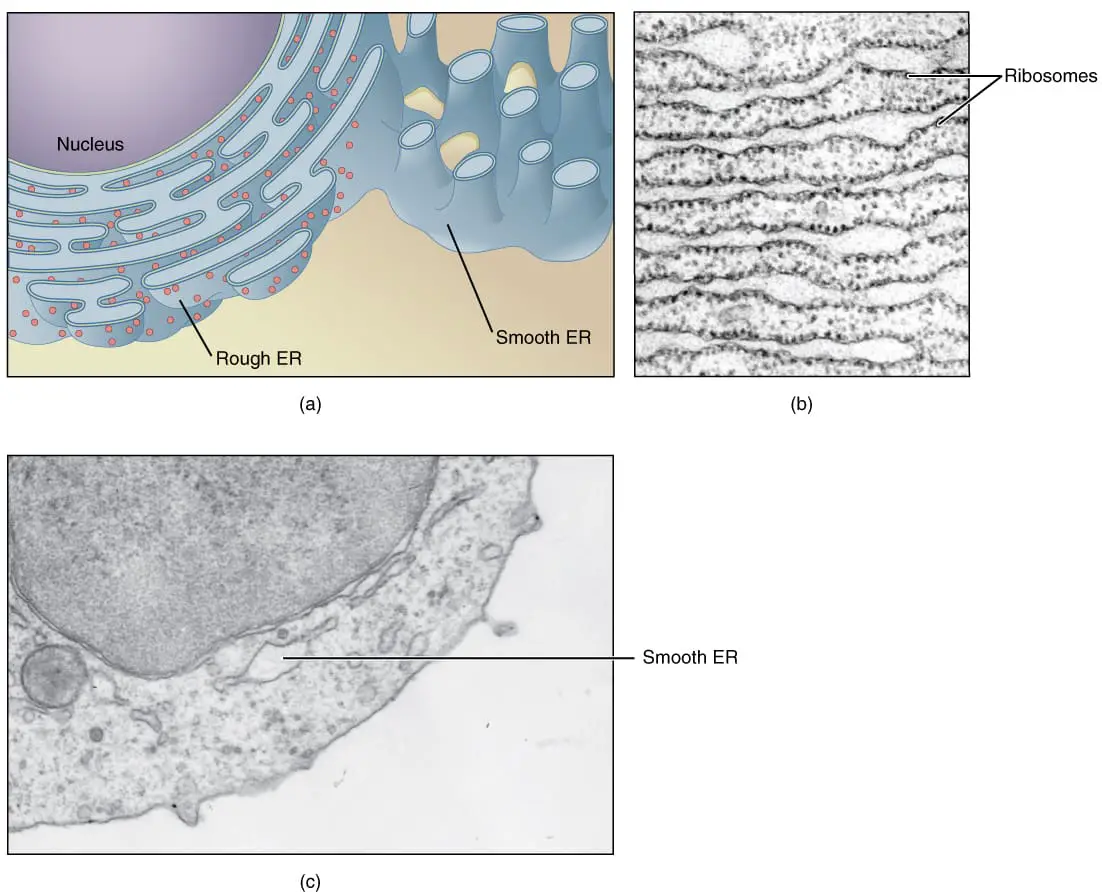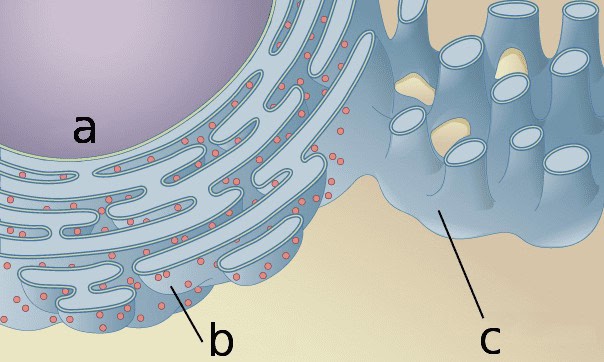The Endoplasmic Reticulum is a corporation of layers that’s available inside eukaryotic cells.
These designs are responsible for the creation and transportation of proteins, fats, and other particles needed for the instant working of a cell.
Albeit a fundamental part of the cell, only one out of every odd kind of cell is marked for the presence of endoplasmic reticulum, for instance, red platelets don’t have an ER.
Cells that assume a big part in the creation of proteins and oils have lots of Endoplasmic Reticulum.
Key Takeaways
- The smooth endoplasmic reticulum is responsible for lipid synthesis, carbohydrate metabolism, and detoxification, whereas the rough endoplasmic reticulum is responsible for protein synthesis and processing.
- Smooth endoplasmic reticulum lacks ribosomes on its surface, whereas rough endoplasmic reticulum has ribosomes attached to its surface.
- The smooth endoplasmic reticulum is found in various cells, such as liver and muscle cells. In contrast, the rough endoplasmic reticulum is found in cells that produce large amounts of protein, such as pancreatic cells and cells that produce antibodies.
Smooth Endoplasmic Reticulum vs Rough Endoplasmic Reticulum
The difference between Smooth Endoplasmic Reticulum and Rough Endoplasmic Reticulum is the availability or, say, presence of ribosomes. The SER is known for loading lipids and proteins. It isn’t limited by ribosomes. Meanwhile, the Rough Endoplasmic Reticulum is limited to ribosomes and stores proteins.

Smooth Endoplasmic Reticulum or SER gives off an impression of resembling a smooth surface when seen from the electron magnifying instrument as they don’t contain ribosomes.
They are otherwise called Agranular Endoplasmic Reticulum. The SER assumes an indispensable part in the creation, stockpiling, and discharge of steroid chemicals and lipids.
It likewise helps in the assembling system of new films and the digestion of sugars.
Rough Endoplasmic Reticulum or RER resembles a lopsided surface due to the presence of the 80S ribosomes when seen in the electron magnifying instrument.
It is otherwise called the Granular Endoplasmic Reticulum. The principle capacity of the RER is to participate in the protein blend and helps in the transportation of the protein to different parts.
Comparison Table
| Parameters of Comparison | Smooth Endoplasmic Reticulum | Rough Endoplasmic Reticulum |
|---|---|---|
| Definition | The Smooth Endoplasmic Reticulum doesn’t have ribosomes on its film. | Rough Endoplasmic Reticulum has ribosomes appended to its layer. |
| Coordinated | It is coordinated by vesicles and tubules. | It is coordinated with cisternae and a couple of tubules. |
| Synthesis | Synthesizes glycogen, lipids, and steroids. | Synthesizes enzymes and proteins. |
| Present | The smooth endoplasmic reticulum is principally made out of an organization of tubules. It is for the most part found close by the cell layer. | The rough endoplasmic reticulum is a piece of the endomembrane framework that is available in the cytoplasm of the cell. |
What is Smooth Endoplasmic Reticulum?
The endoplasmic reticulum does not have ribosomes on its surface. The smooth endoplasmic reticulum does not have ribosomes on its surface.
Smooth ER is associated with the atomic envelope and spreads all through the cytoplasm.
It comprises a film-encased organization of tubules and vesicles shaped in a reticular example that takes into consideration an expanded surface region for the activity or capacity of key proteins.
The inside of the smooth endoplasmic reticulum is known as the lumen, which is encased by a phospholipid film. The Smooth Endoplasmic Reticulum assumes a pivotal part in cell digestion.
The assorted metabolic cycles where SER has included changes as per the cell type are discovered to be bountiful in certain cell types that depend intensely on SER capacities.
SER contains a wide scope of proteins associated with the blend of lipids, particularly the biosynthesis of phospholipids and steroids.
The smooth endoplasmic reticulum likewise assumes a key part in cholesterol homeostasis. The smooth endoplasmic reticulum is additionally engaged with the exchange of atoms created in the unpleasant ER to the Golgi complex.

What is Rough Endoplasmic Reticulum?
The Rough Endoplasmic Reticulum is a piece of the endomembrane arrangement of the cell and a subset of the endoplasmic reticulum (ER).
This organelle is fundamentally concerned about the union, collapsing, and change of proteins, particularly those that should be conveyed to various organelles inside the cell or discharged from the cell.
The Rough ER is portrayed by the presence of layer-bound ribosomes that give it a particular appearance under the magnifying lens.
These ribosomes look like studs and recognize the organelle from the smooth segments of the ER. A few proteins are additionally combined by a series of ribosomes called polysomes.
The lumen of the rough ER borders with the perinuclear space, and the layers of the rough ER are related to the external atomic film.
The ER can be morphologically separated into two designs cisternae and sheets. The rough endoplasmic reticulum is, to a great extent, made of sheets – a two-dimensional exhibit of levelled sacs that stretch out across the cytoplasm.

Main Differences Between Smooth Endoplasmic Reticulum and Rough Endoplasmic Reticulum
- The presence of SER resembles it contains numerous round marks. These imprints are the interlocking rounded sheets, though the Rough ER seems like the association of the twofold films, which are spotted with the ribosomes everywhere. RER comprises equal sheets of film.
- The Smooth ER is situated close to the cell film, while the Rough ER is situated close to the cytoplasm of the eukaryotic cells.
- SER springs from the rough endoplasmic reticulum by sacrificing the ribosomes, whereas RER originates from the nuclear membrane.
- The principal contrast between the Smooth ER and Rough ER is the presence of ribosomes, as the SER doesn’t comprise ribosomes however, RER comprises ribosomes.
- SER makes and transports the lipids and protein, and it helps in detoxification, while RER helps in the creation, discharge, and transportation of the proteins and hardly any chemicals.
- https://www.britannica.com/science/smooth-endoplasmic-reticulum
- https://www.vedantu.com/biology/difference-between-smooth-endoplasmic-reticulum-and-rough-endoplasmic-reticulum

The detailed descriptions of smooth and rough Endoplasmic Reticulum highlight their structural differences and distinct roles in lipid and protein metabolism, expanding our understanding of cellular processes.
The specialized functions of smooth and rough Endoplasmic Reticulum illuminate the unique roles of these organelles in synthesizing lipids and processing proteins, contributing to cellular homeostasis.
The presence or absence of ribosomes defines the smooth and rough Endoplasmic Reticulum, which reflects their unique roles in lipid synthesis and protein processing.
Absolutely, the fundamental differences in the internal structure of the two types of Endoplasmic Reticulum are fundamental for cellular functionality.
The specialized functions of smooth and rough Endoplasmic Reticulum illustrate their importance in cellular metabolism and protein synthesis, contributing to the cell’s vitality.
Understanding the intricate roles of smooth and rough Endoplasmic Reticulum enhances our knowledge of cellular dynamics and the regulation of vital cellular components.
The distinction of the smooth and rough Endoplasmic Reticulum uncovers the complexity and specificity of cellular processes, emphasizing their significance in cellular function.
The Endoplasmic Reticulum plays a crucial role in the cell’s function, influencing lipid and protein synthesis and metabolism. It is fascinating to see how it contributes to cellular homeostasis and function.
The comparison between smooth and rough Endoplasmic Reticulum is intriguing, especially the distinction of ribosomes on their surfaces.
I agree, the Endoplasmic Reticulum has essential functions, and understanding its role in different cell types is of great interest.
The functions of smooth and rough Endoplasmic Reticulum in synthesizing lipids, processing proteins, and aiding in detoxification underscore their vital contributions to cellular processes and overall cell function.
The specialized roles of smooth and rough Endoplasmic Reticulum provide a comprehensive understanding of their significance in cellular metabolism and protein synthesis, emphasizing their crucial roles in the cell.
This detailed comparison between smooth and rough Endoplasmic Reticulum enhances our understanding of their roles in cellular processes and their distinct functionalities.
The unique roles and structures of smooth and rough Endoplasmic Reticulum contribute significantly to cellular metabolism and protein synthesis.
It’s fascinating to see the differences in the composition and functions of these organelles, emphasizing their importance in cellular homeostasis.
The intricate details regarding the differences between smooth and rough Endoplasmic Reticulum offer valuable insights into their diverse roles, highlighting their importance in cellular dynamics and metabolism.
The detailed comparison of smooth and rough Endoplasmic Reticulum provides essential knowledge of their specialized functions, shedding light on their unique roles in cellular processes.
The distinction between smooth and rough Endoplasmic Reticulum enhances our understanding of their unique contributions to cellular functions, emphasizing the complexity of cellular metabolism.
The comparison of smooth and rough Endoplasmic Reticulum provides a comprehensive view of their unique functions and their essential contributions to cellular activities.
It’s intriguing to see how the differences between smooth and rough Endoplasmic Reticulum influence the metabolic activities and protein synthesis within the cell.
The distinction between Smooth Endoplasmic Reticulum and Rough Endoplasmic Reticulum, in terms of their structural and functional differences, provides valuable insights into cellular processes.
I find it remarkable how each type of endoplasmic reticulum is specialized in different cellular functions, it’s truly an intricate system.
The comparison table provided here simplifies the differentiation between smooth and rough Endoplasmic Reticulum, shedding light on their specific activities within the cell.
I find it intriguing how the unique characteristics of smooth and rough Endoplasmic Reticulum influence their roles in different cellular processes.